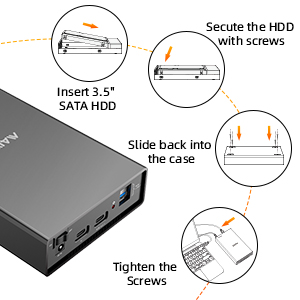In the fast-evolving world of computer hardware, understanding the specifications and terminologies associated with various components is crucial. One such term that holds immense importance in the realm of data storage is "3.5" SATA." This seemingly complex term actually encapsulates key features and functions that impact how data is stored, transferred, and accessed within computers and external devices. In this article, we will delve into the depths of 3.5" SATA, explaining its meaning, significance, and functionality.

Decoding the Terminology:
The term "3.5" SATA" can be broken down into two primary components: "3.5"" and "SATA."
3.5": This refers to the physical size of the hard drive or storage device. It indicates that the device is designed to fit into a standard 3.5-inch drive bay found in most desktop computer cases. The 3.5-inch measurement is a standard in the computing industry and has been widely adopted for internal hard drives and other storage solutions.
SATA: SATA stands for Serial Advanced Technology Attachment, and it refers to the type of interface used for connecting storage devices to a computer's motherboard. SATA is a technology that allows for the transfer of data between the storage device and the computer. It has replaced older interfaces like IDE (Integrated Drive Electronics) due to its improved data transfer rates and efficiency.
Significance of 3.5" SATA:
The combination of these two components, "3.5"" and "SATA," holds significant importance for several reasons:
Compatibility: Devices labeled as 3.5" SATA are designed to fit perfectly into the 3.5-inch drive bays commonly found in desktop computers. This standardization of size ensures that the device can be seamlessly integrated into a variety of computer setups.
Higher Capacities: 3.5" SATA drives are typically larger than their 2.5" counterparts, allowing them to accommodate more storage components. This additional space often translates to higher storage capacities, making 3.5" SATA drives suitable for applications that demand ample storage, such as multimedia content creation and server setups.
Improved Cooling: The larger physical size of 3.5" SATA drives allows for better heat dissipation. This is especially relevant in high-performance scenarios where the drive might experience continuous heavy usage. The improved cooling can contribute to maintaining optimal performance and prolonging the drive's lifespan.
Functionality of 3.5" SATA:
The functionality of a 3.5" SATA drive extends beyond its size and compatibility:
Data Transfer: The SATA interface, denoted by the term SATA, is responsible for facilitating data transfer between the storage device and the computer's motherboard. The "Serial" aspect of SATA indicates that data is transferred sequentially, bit by bit. SATA interfaces have gone through various iterations, with each iteration improving data transfer speeds. The most common iterations include SATA I, SATA II, SATA III, and SATA 3.2, each with increasing data transfer rates.
Storage Solutions: 3.5" SATA drives find application in various storage scenarios. They are commonly used as internal hard drives in desktop computers, providing the primary storage for the operating system, applications, and user data. Additionally, they are utilized in network-attached storage (NAS) devices and external enclosures to create scalable and accessible storage solutions.
RAID Configurations: 3.5" SATA drives play a crucial role in RAID (Redundant Array of Independent Disks) configurations, where multiple drives are combined to enhance performance, redundancy, or both. These configurations are often employed in server environments to ensure data integrity and availability.
Conclusion:
In conclusion, the term "3.5" SATA" encapsulates the physical size and interface technology of a storage device. The 3.5" size is standardized to fit into typical desktop computer drive bays, while the SATA interface ensures efficient data transfer between the storage device and the computer. The combination of these attributes makes 3.5" SATA drives versatile components used in various storage applications, from personal computing to enterprise-level solutions. Understanding the significance and functionality of 3.5" SATA drives empowers users to make informed decisions when selecting storage solutions that align with their computing needs.